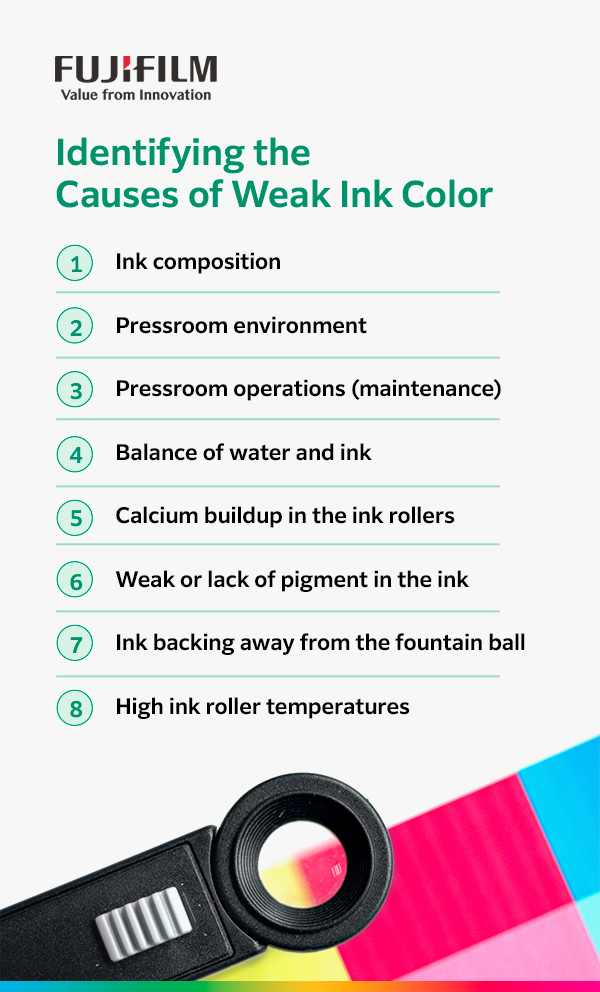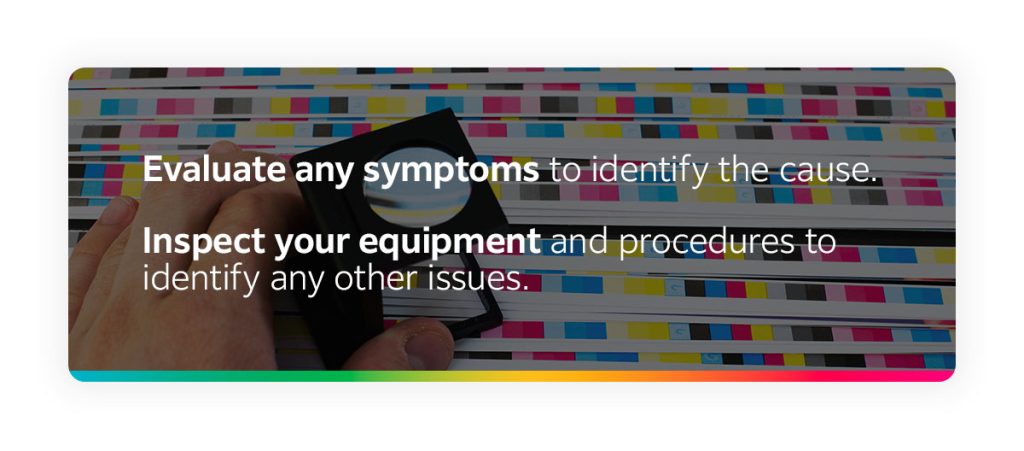
Regardless of the type of printing, from flexographic printing to gravure printing, pressrooms will run into ink issues. Weak ink color often creates faded or low-resolution prints, decreasing customer satisfaction. Fortunately, you can solve these issues as quickly as they arise if you understand their causes and implement the correct preventative measures.
Incorporating these methods can help you improve print quality and minimize time spent on larger troubleshooting tasks. In this pressroom troubleshooting guide, you’ll learn how to recognize the symptoms of weak ink color, its causes and tips for fixing your issue.
It’s easy to spot when your ink is getting weak in color because of the visual signs and its impact on the print quality. Let’s look at some key indicators that your pressroom is having ink issues.

Weak ink can cause various quality issues, such as reduced longevity, smearing and poor adhesion, depending on its cause. You might encounter weak ink when there is an imbalance of certain measurements. For example, ink viscosity and surface tension require an equal balance to produce high-quality printing.
Here are a few more examples of the effect weak ink color can have on the most common printing techniques:
Weak ink color in offset lithography printing usually comes from an imbalance of ink to water, non-uniform dampening or the incorrect concentration of fountain solution. These issues can result in some of the previously mentioned signs, including excessive dot gain, ghosting, ink misting and mottling.
Weak ink color in flexographic printing is typically related to little colorant ink formulation, insufficient colorant dispersion in the ink or incorrect pigmentation. While mild color strength variations can still create accurate images, weak ink color strength may make flexographic images appear streaky or faint. You may even notice inconsistencies throughout the print job and gain more pronounced colors than intended.
You may be experiencing ink and color issues in the pressroom for many reasons, and knowing what they are is important. When you understand why certain problems occur, you’ll have a better idea of how to handle them. Here is a deeper look at the key factors impacting ink color intensity.

The components of the ink you use are directly related to your color strength because they affect the ink viscosity. If you have a higher viscosity, the ink will be thicker and take longer to flow, while a lower viscosity will make it thinner and flow more quickly. Using the correct viscosity measurements is critical to obtain the required color strength.
Components like pigments, resins and binding agents form your ink and impact the viscosity and strength of the color. These components also influence qualities like dot gain, ink lay and trapping, which affect the overall quality of your print job.
If you’ve been in a situation where the ink color looks appropriate but turns out slightly different when you start printing, the issue could be the lighting. Various light sources affect visual color strength, causing colors to vary when viewed under other lights. Some pressroom environments lack the natural light needed to promote consistent results.
While efficiency is essential in any workplace, so is maintenance. Some companies emphasize productivity to improve customer satisfaction, although this may impact quality if they avoid cleaning press rollers. You may find that dirty prints and incorrect color matches can occur when staff doesn’t properly maintain press rollers.
Another common yet overlooked cause is too much water in the ink, which weakens the color strength. This imbalance may also affect the ink’s flow and consistency, causing it to smudge or create ink mist, excessive dot gain or inconsistent print density.
If you’ve noticed a framing effect around your print jobs, it’s probably due to calcium buildup. Calcium may nest in the nonimage area, blanket surface, and impression cylinder so that you cannot print a clean background when you transfer ink.
A good concentration of well-dispersed pigment promotes excellent color strength, stability and clear color shades. When there is a lack of pigment or poor dispersion, the ink becomes more transparent and causes the color to look weaker.
You may have issues achieving the correct colors when the ink frequently backs away from the fountain ball. This issue often occurs because the ink is too short and cannot flow and properly follow the fountain ball, causing a non-uniform color.
Stay mindful of the temperatures you use with ink. If your ink roller temperature gets too high, the ink viscosity decreases and changes the ink’s color. Even the smallest temperature changes can affect the ink viscosity, so be sure to maintain a steady temperature to avoid weak ink color.
You can implement preventive maintenance to avoid ink and color issues in pressrooms. You may need to do these tasks daily, monthly or weekly, depending on the seriousness of the problem. Regular maintenance and calibration offer crucial benefits. Here are the most significant advantages of preventive maintenance:
Two effective approaches to troubleshooting weak ink color issues are taking a systematic approach or using a troubleshooting guide. Both offer valuable ways to deal with pressroom ink issues. Understanding both methods and effective techniques can help ensure you resolve any problems.
If you are unsure what the underlying issue is, you may take a systematic approach to troubleshooting by thoroughly monitoring and inspecting all equipment and processes. First, evaluate any symptoms to identify the cause. Next, inspect your equipment and procedures to identify any other issues. You may even speak with a professional for further help examining the situation.

Once you know what the issue is, you can use these options to find the solution. You may even use some of these solutions for regular maintenance checkups. Here are the steps you can take to fix common issues and strengthen ink color:
Some companies have their own internal pressroom troubleshooting guide specific to their equipment. If your organization has these, you may find it beneficial to review them. Other companies are without troubleshooting guides or have outdated copies. In this case, look for manufacturer guides or other resources for efficient troubleshooting, such as this guide.
Effective problem recognition, understanding causes, implementing preventive measures and employing effective troubleshooting techniques are the keys to keeping your pressroom up and running. Weak ink can cause various adverse side effects in the printing process. Take extra precautions to avoid lost productivity, increased waste and higher costs due to press downtime.
If you’ve tried our troubleshooting tips and are still experiencing issues, it might be a sign that you need to upgrade your equipment. FUJIFILM Graphic Communication offers excellent printing solutions to help minimize downtime and maximize print quality.
From effective color management software to various printing equipment for different printing techniques, we provide a comprehensive selection of printing essentials to keep your workplace running. We welcome you to contact our experts today for more information.